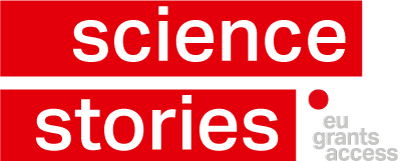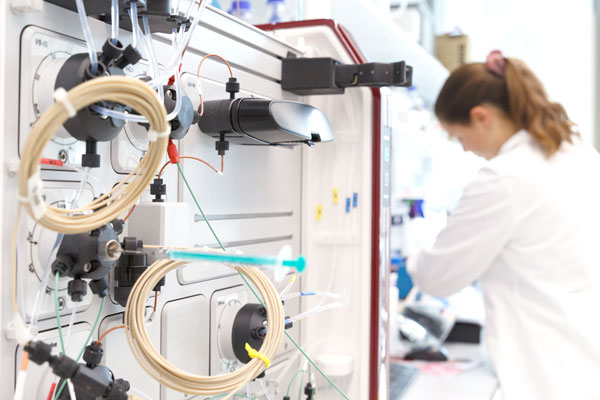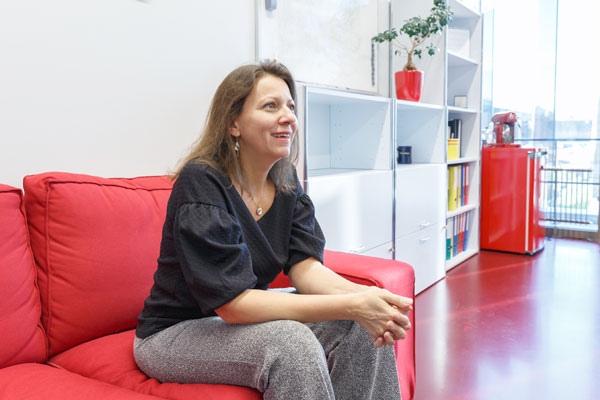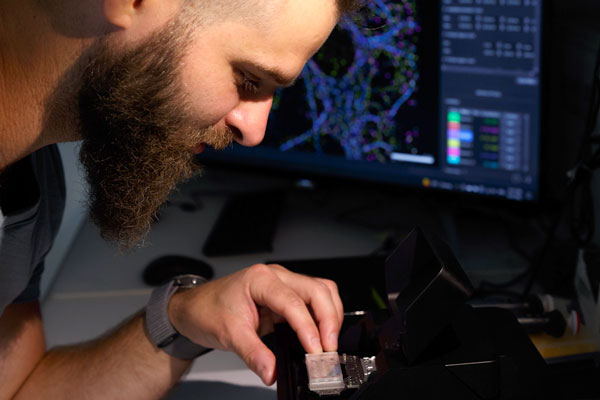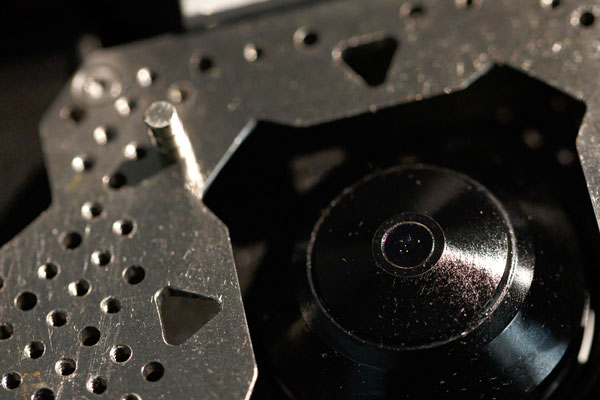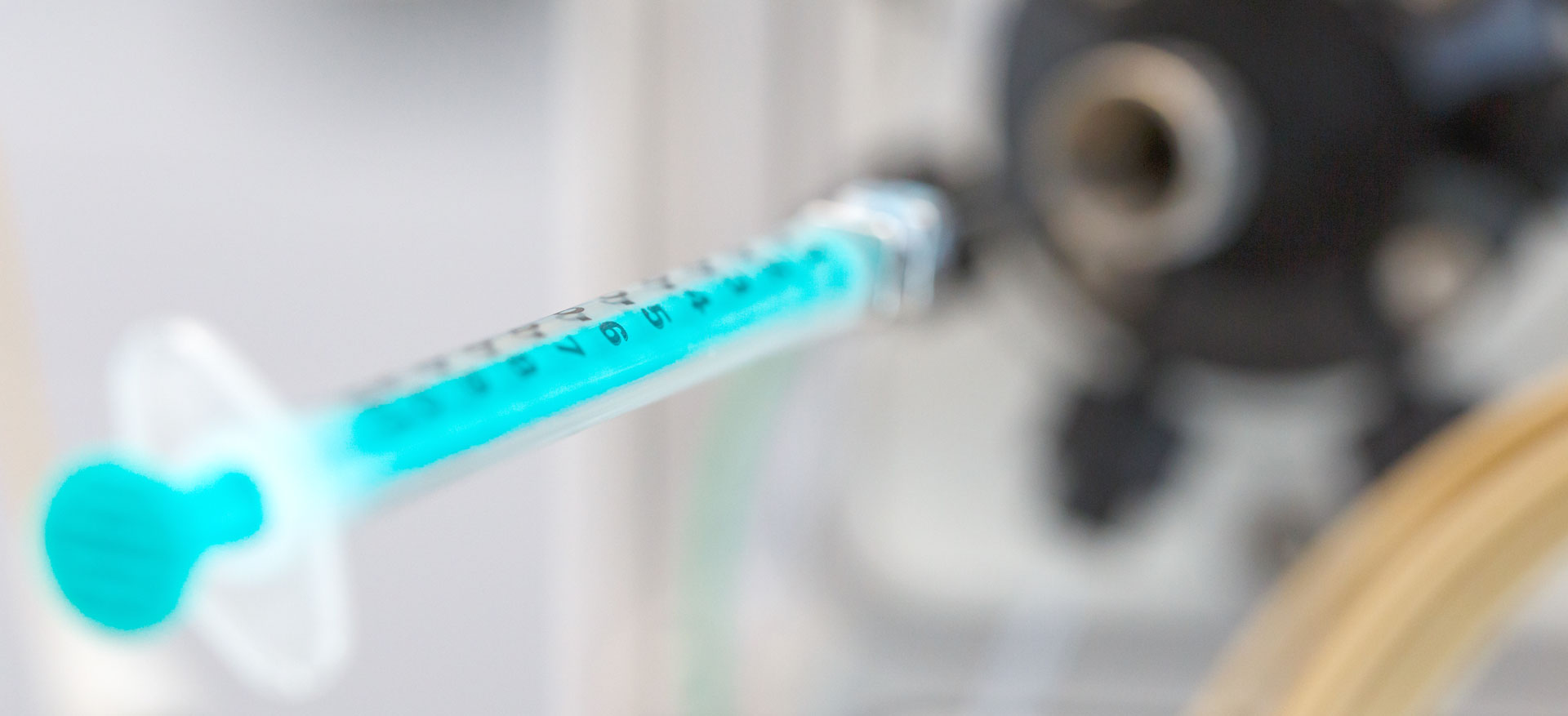
A new perspective on neurodegenerative diseases
She has dedicated herself to the same topic for over ten years: Magdalini Polymenidou researches the molecular mechanisms of the neurodegenerative diseases ALS and FTLD and is directly supported by the NIH for this purpose: a portrait of the biomedical scientist from the University of Zurich.
Her office is small, but personally furnished with a red sofa and additional utensils. And she walks to work because she lives very close by. Magdalini Polymenidou clearly feels at home at the Irchel campus of the University of Zurich and on this morning, she is also very happy with herself and the world. Because, she tells us, she will probably soon be able to announce a decisive advance in her research.
The scientist from Greece has dedicated herself to the fight against amyotrophic lateral sclerosis, or ALS for short, the fatal disease made world-famous by Stephen Hawking. And also the lesser-known frontotemporal lobar degeneration (FTLD), a similar disease that attacks the brain instead of the motor function. In both diseases, proteins such as TDP-43 accumulate in the nerve cells. The molecular mechanisms that trigger this process are still unclear. Magda Polymenidou, as she calls herself for short, runs the POLYlab and with it a multidisciplinary team consisting of neuroscientists, molecular biologists, biochemists, RNA biologists and bioinformaticians, working together to understand these mechanisms. The goal is to develop a therapy for the two fatal diseases.
New developments
Of all things, why did she choose these rare diseases? Magda Polymenidou smirks: «In a way, I came to this field by chance. When I studied pharmacy in Thessaloniki, I knew I wanted to work in research, but there were not many opportunities in Greece.» The only laboratory that offered student positions dealt with neurodegenerative diseases, the prion diseases. „This is how I came to this fascinating field,“ the professor explains. After her doctorate, which she subsequently completed in a laboratory in Zurich, she decided to dedicate herself to ALS, because there were some new developments in the field at the time, especially in the area of genetics, which enabled scientists to explore the mechanisms of the disease.
«This is probably the most
tragic dimension of the disease:
the patients are one hundred
percent aware of
what is happening to them.»
ALS is a very well-known disease because of Stephen Hawking. But according to statistics, only one to two people per 100,000 die from it each year – and Hawking, who survived the disease for decades, is an absolute exception. «I know one of the neurologists who followed his illness,» the researcher tells, «and after his death Hawking gave his body to science. That is how we know that he was not a special genetic case. It is not known why he was able to survive so long.» In all patients, however, the brain remains completely intact. “This is probably the most tragic dimension of the disease: the patients are one hundred percent aware of what is happening to them,” Magda Polymenidou explains. Other neurodegenerative diseases are usually accompanied by dementia.
Experience from the US
The biomedical scientist is currently working with a grant from the US NIH – and as the main recipient. This is a novelty in Zurich – normally American institutions submit an application to the NIH and then pass on part of the research to Swiss researchers in the form of a so-called subaward. For her part, Magda Polymenidou has granted a subaward to the biotech company Mabylon, with which she has been collaborating since 2015. «I was a postdoc in the US and involved in several NIH Grants there. So, I had experienced how these grants work,» she explains. When the partners from Mabylon raised the need to generate external funding, the idea of applying to the NIH came up. «Then we got really promising data from our research, so we tried and applied for an NIH Grant,» she explains – and laughs: «Luckily, I didn’t know how small the chances were without an American partner, otherwise we might not have tried at all.» In fact, she says, American colleagues also expressed their surprise that she was the main recipient of this support.
Magda Polymenidou has been researching ALS for more than ten years. In 2011, as a postdoc in San Diego, her work showed that the loss of TDP-43 leads to errors in the splicing of pre-mRNAs to mature mRNA – the protein TDP-43 is at the heart of ALS research. «At that time, we understood which mRNA molecules, so-called TDP-43 target mRNAs, are influenced by this protein,» she states. In 2013, she came to the University of Zurich and started research with her own group.
A milestone ahead
In the meantime, research in this field has made a lot of overall progress. Magda Polymenidou specifies: «In the international scientific community, at least two new candidates of TDP-43 target mRNAs responsible for the loss of nerve cells are known so far. And our group has just discovered another one!» A publication on this is in preparation and could appear as early as the end of the year or at the beginning of 2023. According to the discoverer, this mRNA codes for a synaptic protein that is important for the communication of nerve cells. It is found in diseased cells and in much larger quantities than in healthy cells.
«Everyone who has reached
a certain level has had failures
and frustrations to overcome.»
For studies at the molecular level, the group works with cell extracts. For studies on what happens in the brain, post-mortem material is available. According to Magda Polymenidou, there are worldwide initiatives for this, especially in the USA and the UK. This is because ALS and FTLD are far too rare to simply obtain tissue in one’s own environment. The donated tissue is delivered with the clinical data and distributed among researchers worldwide. The POLYlab is part of this.
Experiments on mice are also being carried out, but probably not for much longer. “We are now finding that the molecular mechanisms in this disease are human-specific,” explains the researcher. Therefore, you cannot study them in mice. The group is therefore working increasingly with human nerve cells that mature in the laboratory.
The power of images
And what does the group leader like to do most about her work? The answer comes quickly: «Look at the new data and discuss it with my students. And planning the next step. The moment when we have a new result, expected or not, and when we realise we are one step closer to our goal, that is the best part of my job.» She already felt that way when she was still working in the lab. Today, she is no longer to be found there very often. But she still has a favourite piece of equipment: the super resolution microscope that stands in a darkroom. It is one of the devices she bought when she was first able to order her own equipment as an associate professor – and the most expensive. With it, the group can observe even minuscule structures in the cells. And now that the group is turning its attention to synapses, the tiny connections between nerves, this microscope makes a huge difference.
Her sons, aged four and ten, also love to see images of nerve cells, the researcher says – “and they always want to know which is the healthy part and which is the diseased part”.
Luck and perseverance
In November, the NIH project came to an end. No problem for Magda Polymenidou: “We are now in the fortunate position of having various options for funding the further research,” she says. In June, she received an ERC Consolidator Grant, but could not accept it without leaving Switzerland – and that was not an option for her. Now, however, the State Secretariat for Education, Research and Innovation SERI of the Swiss Confederation has stepped in and compensated for the prize money. The researcher is also very well connected: “We know various foundations that support translational research. That’s where we want to dock.»
In general, Magda Polymenidou feels quite privileged: her husband also works as a scientist. Together they were able to go to the USA as postdocs, and together they came back and found jobs here. Without her stay in the USA, however, she states that she would not have come this far.
And what would she have become if not a scientist? The professor laughs again: “When I could hardly speak, I already said that I wanted to be a researcher – at least this is what my family tells me.” She always wanted to work with diseases. She used to think of becoming a doctor. But then she wanted to know why we get sick in the first place and understand this process. And she had perseverance. Not everything worked out the first time. “I could have given up whenever I failed at something,” she recalls and adds, “Everyone who has reached a certain level has overcome failures and frustrations.” That’s the only way to get to the next level, and, “We should keep saying that especially to the young generation. Because many only see the shiny success.”
Interview with Magdalini Polymenidou
Magdalini Polymenidou
Magdalini Polymenidou is Associate Professor for Biomedicine at the Department of Quantitative Biomedicine of the University of Zurich. Originally trained as a pharmacist at the Aristotle University of Thessaloniki (Greece), she did her PhD on prion diseases in the laboratory of Adriano Aguzzi at the University Hospital of Zurich. As a postdoctoral fellow in the group of Don Cleveland at the University of California in San Diego (USA), she dealt with the development of amyotrophic lateral sclerosis (ALS) and frontotemporal dementia (FTD). In 2013, she joined the University of Zurich as an SNSF Assistant Professor. In 2019, she was promoted to Associate Professor. Magdalini Polymenidou was awarded the EMBO Young Investigator Award (2018), the Georg-Friedrich Götz Prize (2015), the SNSF Professorship (2013), the HFSP Career Development Award (2013) and the NIH Pathway to Independence Award (2011). When not in the lab, Magdalini Polymenidou enjoys family time, especially with her two sons, Lennart, born in San Diego in September 2012, and Kilian, born in Zurich in 2018.
NIH Project
Development of immunotherapy targeting TDP-43 pathology in ALS and FTLD
- Pogramme: Collaborative project with 2 partners
- Duration: 15. June 2020 – 30. November 2022 (29.5 months)
- Contribution for the consortium: 236’307 €
